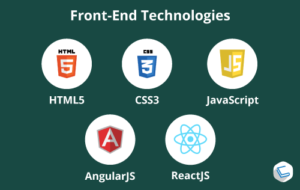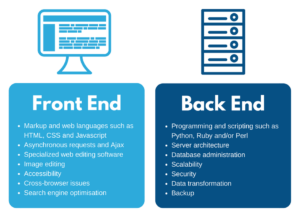If you are just starting website development, you probably have heard a lot of talk about website design, frontend and backend development. It is quite normal to be confused. They all sound the same.
Essentially, the difference between frontend and backend web development is that the first one serves the client side (what we see on the front i.e. a screen) and the latter is supporting the server side (what’s under the hood of a website).
While these two types of programming are certainly distinct from one another, they’re also like two sides of the same coin. A website’s functionality relies on each side communicating and operating effectively with the other as a single unit.
Frontend developers don’t actually design these front-facing aspects of a website—this is the job of a web designer, or more specifically, a UI designer. Web designers are concerned with design: the look and feel of the website, how it’s laid out, and what buttons and touch points the user experiences. Frontend developers are concerned with functionality; the engineering that transforms these designs into a live, interactive website using the front end languages.
What is Front End Development?


The frontend of a website is what you see and interact with on your browser. Also referred to as “client-side.” It includes everything the user experiences directly: from text and colors to buttons, images, and navigation menus.
The main front-end languages are HTML (Hyper Text Markup Language), CSS (Cascading Sheet Style) and JavaScript. HTML creates and organizes web content so it can be displayed by a browser. CSS accompanies HTML and defines the style of a website’s content, such as layout, colors, fonts, etc. JavaScript is a programming language used for more interactive elements like drop down menus, modal windows, and contact forms.
Other front end tools are web frameworks like Bootstrap, Django, and Angular, JavaScript libraries like React, jQuery, and CSS extensions like Sass and LESS.
Together these essentials create everything that’s visually presented when you visit a webpage—whether it’s online shopping, reading the news, checking your email, or conducting a Google search.
What is Back End Development?


The backend (or “server-side”) is the portion of the website you don’t see. It’s responsible for storing and organizing data, and ensuring everything on the client-side actually works. The backend communicates with the frontend, sending and receiving information to be displayed as a web page. Whenever you fill out a contact form, type in a web address, or make a purchase (any user interaction on the client-side), and your browser sends a request to the server-side, which returns information in the form of frontend code that the browser can interpret and display.
Some common backend languages are Ruby, PHP, Java, .Net, and Python. These programming languages often run on frameworks that simplify the web development process.
One Final Word


The distinction between frontend and backend is not always so clear-cut. Some developers are proficient in both the frontend and backend; these are what are known as full-stack developers.
If you still have any grey area in website development and you want clarification, be sure to send a private message. See bio for links.
I also help with mentorship, training and services in web development. See my signature for contact details.









